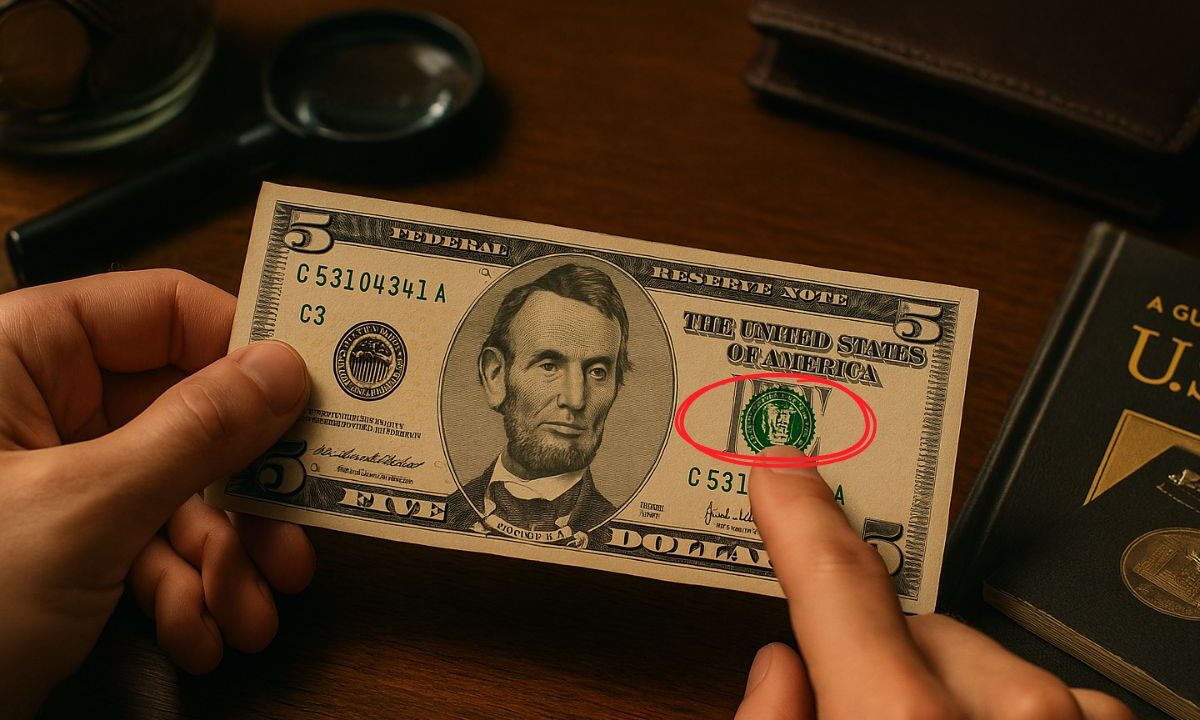In the world of currency collecting, error notes hold a special allure. Among these, the 1995 $5 bill with an inverted seal stands out as a rare and valuable find.
Such misprints occur during the high-speed printing process at the Bureau of Engraving and Printing, leading to unique anomalies. If you’re fortunate enough to possess one, it could be worth significantly more than its face value.
Understanding the Inverted Seal Error
An inverted seal error happens when the U.S. Treasury’s green seal, typically printed upright on the right side of the bill, is mistakenly printed upside down.
This misalignment is a result of a printing oversight and is highly sought after by collectors. While such errors are rare, they add a unique character to the bill.
How to Identify a 1995 $5 Bill with an Inverted Seal
To determine if your $5 bill is a rare inverted seal error, follow these steps:
- Examine the Series Year: Look for the series year “1995” printed on the left side of Abraham Lincoln’s portrait.
- Inspect the Treasury Seal: On the right side of the bill, locate the green Treasury seal. In a standard bill, this seal is upright. In the error note, it will be inverted, appearing upside down.
- Check the Serial Numbers: The serial numbers, also in green ink, should match the seal’s orientation. In the error note, these numbers will be upside down relative to Lincoln’s portrait.
- Compare with a Standard Bill: Having a regular 1995 $5 bill on hand can help you spot the differences more easily.
Why This Error Matters
The 1995 $5 bill wasn’t initially known for having many documented printing errors, making the inverted seal even more remarkable.
Experts believe that only a few such examples exist, and most of them were likely spent without the holder ever realizing the error. This rarity adds to the bill’s allure among collectors.
Value and Market Trends
The value of a 1995 $5 bill with an inverted seal can vary based on several factors:
- Condition: Uncirculated bills are worth more than those that are worn or damaged.
- Rarity: The fewer the number of error notes in circulation, the higher the demand and potential value.
- Authentication: Bills that are professionally graded and authenticated tend to fetch higher prices.
For instance, a 1995 $5 bill with an inverted seal recently sold for $74,000 at an auction, underscoring the potential value of such errors.
Tips for Collectors
If you believe you have found a 1995 $5 bill with an inverted seal, consider the following:
- Handle with Care: Avoid folding, creasing, or exposing the bill to moisture.
- Store Properly: Use acid-free holders or currency sleeves to protect the bill.
- Seek Professional Grading: Having the bill graded by a reputable service can authenticate its value and condition.
- Stay Informed: Regularly check auction sites and currency dealer listings to stay updated on market trends.
Information Table
| Feature | Description |
|---|---|
| Series Year | 1995 |
| Treasury Seal | Green, located on the right side of the bill |
| Seal Orientation | Inverted (upside down) in the error note |
| Serial Numbers | Green ink, matching the seal’s orientation in the error note |
| Common Condition | Circulated bills are common; uncirculated bills are rare |
| Market Value | Can range from a few hundred dollars to over $70,000, depending on condition |
| Rarity | Extremely rare; only a few known examples |
Discovering a 1995 $5 bill with an inverted seal in your wallet is akin to finding a hidden treasure. While such errors are rare, they are highly prized among collectors.
By understanding how to identify these bills and properly preserving them, you can ensure that your find retains its value and significance.
Whether you choose to keep it as a unique piece of history or sell it to the highest bidder, an inverted seal bill is a remarkable addition to any collection.
FAQs
How can I tell if my 1995 $5 bill has an inverted seal?
Examine the green Treasury seal on the right side of the bill. If it’s upside down compared to Lincoln’s portrait, and the serial numbers are also inverted, you have an error note.
What is the value of a 1995 $5 bill with an inverted seal?
The value can vary significantly based on condition and demand. A recent sale saw one such bill fetch $74,000 at auction.
How should I store a 1995 $5 bill with an inverted seal?
Store the bill in an acid-free holder or currency sleeve to protect it from damage. Avoid folding, creasing, or exposing it to moisture.
